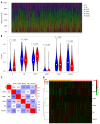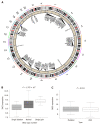Why MUC16 mutations lead to a better prognosis: A study based on The Cancer Genome Atlas gastric cancer cohort
- PMID: 34141777
- PMCID: PMC8173414
- DOI: 10.12998/wjcc.v9.i17.4143
Why MUC16 mutations lead to a better prognosis: A study based on The Cancer Genome Atlas gastric cancer cohort
Abstract
Background: MUC16, encoding cancer antigen 125, is a frequently mutated gene in gastric cancer. In addition, MUC16 mutations seem to result in a better prognosis in gastric cancer. However, the mechanisms that lead to a better prognosis by MUC16 mutations have not yet been clarified.
Aim: To delve deeper into the underlying mechanisms that explain why MUC16 mutations signal a better prognosis in gastric cancer.
Methods: We used multi-omics data, including mRNA, simple nucleotide variation, copy number variation and methylation data from The Cancer Genome Atlas, to explore the relationship between MUC16 mutations and prognosis. Cox regression and random survival forest algorithms were applied to search for hub genes. Gene set enrichment analysis was used to elucidate the molecular mechanisms. Single-sample gene set enrichment analysis and "EpiDISH" were used to assess immune cells infiltration, and "ESTIMATE" for analysis of the tumor microenvironment.
Results: Our study found that compared to the wild-type group, the mutation group had a better prognosis. Additional analysis indicated that the MUC16 mutations appear to activate the DNA repair and p53 pathways to act as an anti-tumor agent. We also identified a key gene, NPY1R (neuropeptide Y receptor Y1), which was significantly more highly expressed in the MUC16 mutations group than in the MUC16 wild-type group. The high expression of NPY1R predicted a poorer prognosis, which was also confirmed in a separate Gene Expression Omnibus cohort. Further susceptibility analysis revealed that NPY1R might be a potential drug target for gastric cancer. Furthermore, in the analysis of the tumor microenvironment, we found that immune cells in the mutation group exhibited higher anti-tumor effects. In addition, the tumor mutation burden and cancer stem cells index were also higher in the mutation group than in the wild-type group.
Conclusion: We speculated that the MUC16 mutations might activate the p53 pathway and DNA repair pathway: alternatively, the tumor microenvironment may be involved.
Keywords: Cancer antigen 125; Gastric cancer; Gene Expression Omnibus; MUC16 mutation; Prognosis; The Cancer Genome Atlas.
©The Author(s) 2021. Published by Baishideng Publishing Group Inc. All rights reserved.
Conflict of interest statement
Conflict-of-interest statement: None declared.
Figures







References
LinkOut - more resources
Full Text Sources
Research Materials
Miscellaneous

